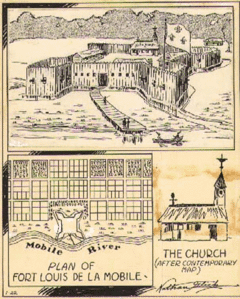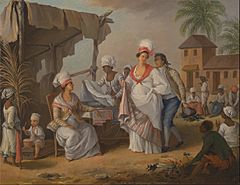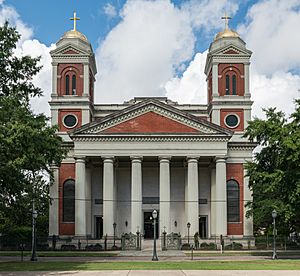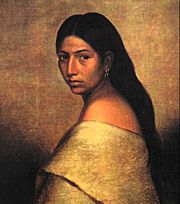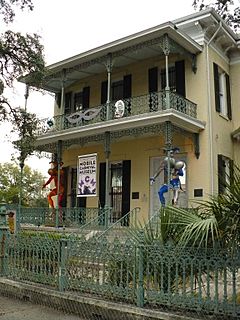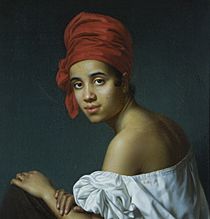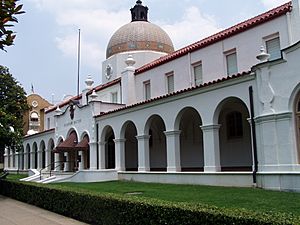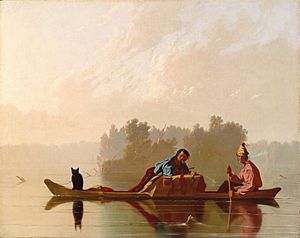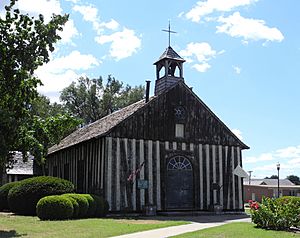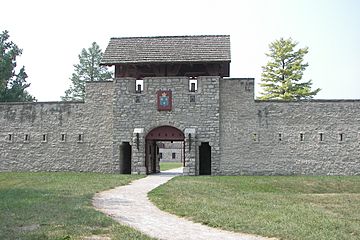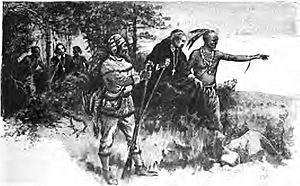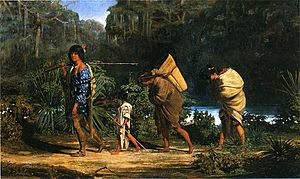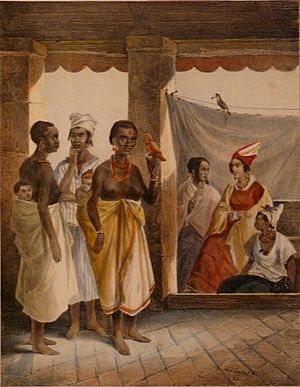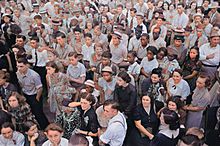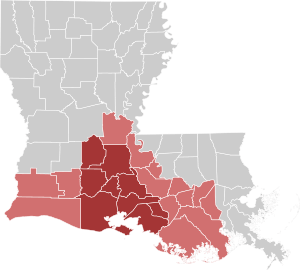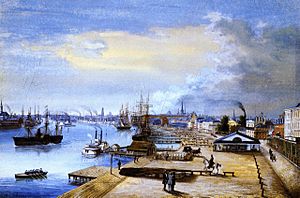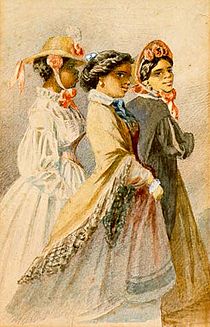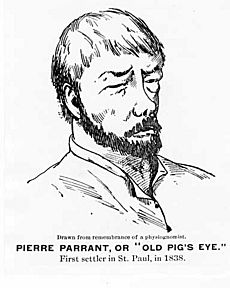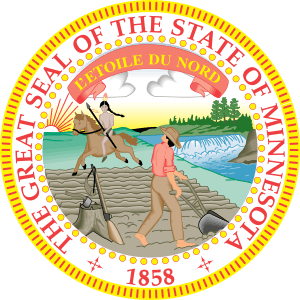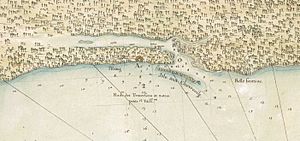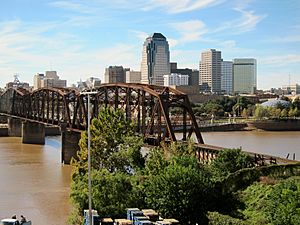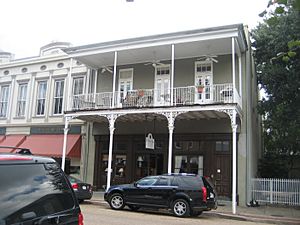French Louisianians facts for kids
| Louisianais | |
|---|---|
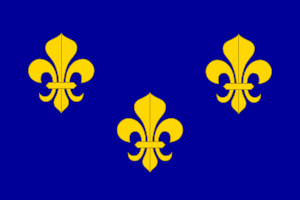
The flag of French Louisiana
|
|
| Total population | |
| Indeterminable | |
| Regions with significant populations | |
| Alabama, Arkansas, Illinois, Indiana, Iowa, Louisiana, Minnesota, Mississippi, Missouri, Ohio, Wisconsin | |
| Languages | |
| Louisiana French Creole French |
|
| Religion | |
| Roman Catholic | |
| Related ethnic groups | |
| French Canadians, Haitians, Latin Americans |
The French Louisianians (French: Louisianais) are also known as Louisiana Frenchmen. They are people of French heritage who live in the states that were once part of French Louisiana. Many people call them French Creoles (French: Créoles). Today, some well-known Louisiana French groups include the Alabama Creoles, Louisiana Creoles (like Cajuns), and the Missouri French.
Contents
- What Does "Creole" Mean?
- Louisiana French Language
- Alabama Creoles: A Rich History
- Arkansas French Indians: A Unique Blend
- Missouri French: Settling the Illinois Country
- Indiana French: Early Explorers and Traders
- Louisiana Creoles: A Unique Culture
- Lower Louisiana: A Melting Pot
- Minnesota French: The "Star of the North"
- Mississippi Creoles: Early Settlements
- Ohio French: "La Belle Rivière"
- Wisconsin French: Fur Traders and Settlers
What Does "Creole" Mean?
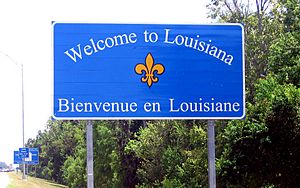
The word Créole was first used by French settlers. It helped them tell the difference between people born in French Louisiana and those born somewhere else. This meant people born in the Viceroyalty of New France were "Creole."
Before states were formed in the Louisiana Territory, people used the term Louisanese (French: Louisianais) for French Louisianians. This term became less common after the Orleans Territory became the State of Louisiana.
Louisiana French Language
- Further information: Louisiana French language, Creole French, and Missouri French
French Louisianians speak different kinds of French. The main types are Lower Louisiana French, Upper Louisiana French, and Creole French.
Alabama Creoles: A Rich History
- Further information: Alabama Creole people
In 1702, explorers led by Pierre Le Moyne d'Iberville founded Mobile in Alabama. French soldiers, French-Canadian fur traders, and their families settled there. Furs were the main way people made money in Mobile. Some settlers also raised cattle.
French colonists and Native American groups like the Choctaw became good friends. They learned each other's languages, like the Mobilian Jargon. Many French settlers also married Native American women. Mobile became a mix of French, French-Canadian, and Native American people.
In 1721, slavery was introduced. Many enslaved people came from the French West Indies. They brought parts of African and Caribbean French Creole culture to Mobile. In 1724, the Code Noir (Black Code) was put in place. This code gave enslaved people some legal and religious rights. It also said that affranchis (freed slaves) had full citizenship.
By the mid-1700s, Mobile was home to many different groups. These included West Indian French Creoles, Europeans, French-Canadians, Africans, and Native Americans. They were all united by the Roman Catholic religion. This diverse group and their descendants are known as Creoles.
Mobile, Alabama: The "Athens of the South"
- Further information: Mardi Gras in Mobile, Alabama
Mobile was a very important city, especially for free Black people. About 40% of Alabama's free Black population lived there. These free people of color were the Creoles. They were a diverse group who created their own schools, churches, and social clubs. Many were descendants of free Black people who kept their freedom after American forces took over Mobile. Some were also related to white families in Mobile.
Mobile became very rich and was called the "Athens of the South." People from Europe and other American cities moved there. By 1860, Mobile had a population of 30,000.
Life in Mobile was full of fun and parties. The wealthy class enjoyed balls, parties, and parades. There were many social clubs and organizations that hosted events. Horse races and cockfighting were also popular.
Mobile was also known for its lively theater. People enjoyed plays by Shakespeare and comedies.
Mardi Gras became very important. Groups called mystic societies started masked parades with bands, floats, and horses. These parades often showed scenes from ancient times.
The Catholic community, mostly French Creole, was large and powerful. They built the Cathedral of the Immaculate Conception. They also built a Catholic school for Creoles. Mobilians supported many book stores and literary societies.
Arkansas French Indians: A Unique Blend
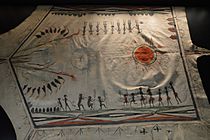
The Quapaw people lived near the Arkansas and Mississippi rivers by the mid-1600s. French explorers like Jacques Marquette and Louis Jolliet learned about them from other Native American groups. They called them Arcansas, which later became "Arkansas."
Écore Fabre (Fabre's Bluff) was an early trading post started by a Frenchman. It was one of the first European settlements in south-central Arkansas. French fur traders and voyageurs had good relationships with the Quapaw. Many Quapaw women and French men married and had families. This created a métis (mixed French Indian) population. For example, Pine Bluff, Arkansas was founded by Joseph Bonne, a man of Quapaw-French métis background.
Missouri French: Settling the Illinois Country
- Further information: Missouri French
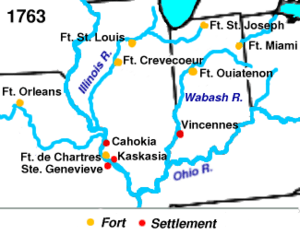
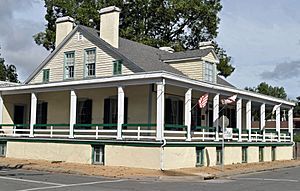
French people began settling this region in the late 1600s. Coureurs des bois (forest runners) from Canada explored the area. They set up missions, forts, and trading posts under the rule of New France.
One of the first towns was Cahokia, founded in 1696. It grew quickly with lots of trade. Jesuit missionaries also started a mission in Kaskaskia in 1703. Canadian settlers moved in and began farming. Some also mined for lead west of the Mississippi River. Kaskaskia became the capital of Upper Louisiana.
Kaskaskia had a diverse population of Native Americans and French voyageurs. Many Canadians became voyageurs and coureurs des bois. More settlers moved to the area, and Sainte-Geneviève was founded in 1735 in what is now Missouri.
In 1732, Vincennes was set up as a French fur trading post. The trade with the Miami was very profitable. French settlers often married women from local Native American tribes. These marriages helped create alliances and trading relationships.
After France lost the French and Indian War in 1763, many French-speaking people moved west of the Mississippi River. They settled in places like Ste. Genevieve and St. Louis. When French Louisiana was sold to the United States in 1803, more French speakers moved inland to the Ozark highlands.
Illinois Country Creoles: Mining and Culture
Native Americans may have already been processing lead in the Upper Louisiana Valley. French demand for lead grew quickly. Entire Creole families moved inland to mine these resources. When Moses Austin settled in Potosi in 1797, he started serious mining operations. This helped the French-speaking community grow. Mining towns like Old Mines and Mine La Motte stayed connected to Ste. Genevieve through trade and family.
Fort de Chartres: A French Castle
In 1718, a company built the first Fort de Chartres in Illinois to protect its mining interests. The fort was the government center for the Illinois Country. It also helped control the Fox Indians. The fort was named after Louis, duc de Chartres.
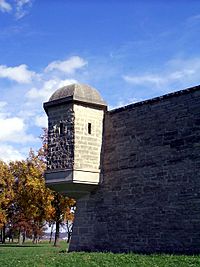
Because of frequent flooding, a new fort was built further inland in 1725. By 1731, the company gave Louisiana back to the king. A new stone fort was built from 1754 to 1760.
The new stone fort was the headquarters for French Illinois Country for less than 20 years. It was given to the British in 1763 after the French and Indian War. The British told settlers to leave or get a special license. Many Illinois Creoles moved across the Mississippi River to live in St. Louis or Ste. Genevieve, Missouri because they wanted to live in a Catholic area.
The British took control of Fort de Chartres in 1765 and renamed it Fort Cavendish. They allowed the Creole people to keep the same rights they had under French rule. In 1768, the British started a Court of Justice, which used common law.
After severe flooding in 1772, the British left the fort. They moved their soldiers to Kaskaskia. The ruined but still standing magazine at Chartres is the oldest European structure in Illinois. It was rebuilt in the 20th century.
Americanization of the Illinois Country
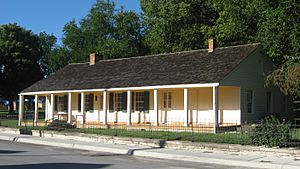
The Louisiana Purchase in 1803 changed things. French speakers in Ste. Genevieve and St. Louis became more like English-speaking Americans. But the mining communities stayed isolated and kept their French heritage.
By the 1820s, lead production in Old Mines went down. After the Civil War, new mining methods made the community poor. French became linked with poverty and lack of education. English speakers sometimes made fun of French speakers. Using French at school was even forbidden.
In the 1930s and 1940s, new mining equipment pushed French-speaking Creoles out of mining jobs. Many Missouri French speakers felt ashamed of their language. By 2014, fewer than 30 Missouri French speakers remained in Old Mines.
Indiana French: Early Explorers and Traders
In 1679, French explorer René-Robert Cavelier, Sieur de La Salle was the first European to enter Indiana. French-Canadian fur traders soon arrived. They traded blankets, jewelry, tools, and weapons with Native Americans for animal skins.
By 1702, the first trading post was set up near Vincennes. In 1715, Sieur de Vincennes built Fort Miami at Kekionga (now Fort Wayne). Another fort, Fort Ouiatenon, was built in 1717 to control trade routes.
In 1732, a second fur trading post was built at Vincennes. French settlers returned in larger numbers. British colonists also arrived, leading to fighting over the fur trade in the 1750s.
Native American tribes in Indiana sided with New France during the French and Indian War. When the British won in 1763, France had to give up all its lands east of the Mississippi River.
Louisiana Creoles: A Unique Culture
- Further information: Louisiana Creole people
Lower Louisiana: A Melting Pot
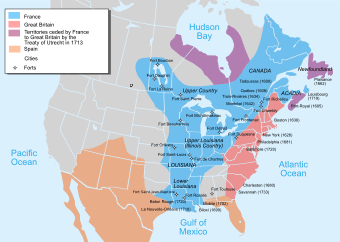
During French and Spanish rule, "Creole" meant ethnic French and Spanish people born in the New World. Parisian French was the main language in early New Orleans. Over time, the local French language changed, adding local words and slang. This became known as Colonial French.
Today, a Louisiana Creole is usually someone whose family was in Louisiana before the Louisiana Purchase in 1803. Only about 7,000 Europeans settled in Louisiana during the 1700s. This was much fewer than in the Thirteen Colonies.
Life in Louisiana was tough for early colonists. They faced a new, often difficult environment with a harsh climate and tropical diseases. Many died during the journey or soon after arriving.
Hurricanes and yellow fever epidemics were common. These conditions slowed down settlement. Also, Native American attacks were a real danger. The Natchez massacred 250 colonists in 1729. The French later attacked the Natchez in return.
French settlers often married Native American women. As enslaved people arrived, settlers also married African women. This mixing of cultures and races created a large multiracial Creole population.
Engagés and Casquette Girls: Building the Population
- Further information: Engagé#White Indentured Servitude in Louisiana and Casquette girl
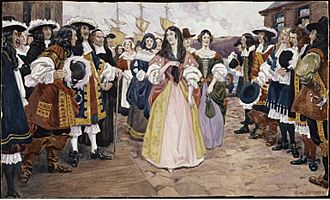
Many early colonists were young men recruited from French ports. Some were engagés (indentured servants). They had to work for a set time to pay for their travel and living costs. In Louisiana, they usually worked for seven years.
To increase the population, the government also sent young Frenchwomen to the colony. They were called filles à la cassette (casket girls) because of the small case of belongings they brought. They were meant to marry colonial soldiers. The king even paid for their dowries.
Some female criminals were also sent to the colony. For example, in 1721, a ship brought nearly 90 women from a Paris prison to Louisiana. Most of them quickly found husbands.
French Indians in Louisiana: Strong Alliances
- Further information: Métis, Choctaw, Mobilian Jargon, and Mississippian culture
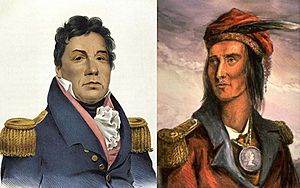
New France wanted Native Americans to become subjects of the king and Christians. But the distance and few French settlements made this hard. Native Americans were mostly independent because they had more people.
Native American tribes were very important to the French. They helped the colonists survive, traded furs, and guided expeditions. French alliances with Native Americans also protected both groups from other tribes and European enemies. This alliance was very helpful during the French and Indian War.
The French and Native Americans influenced each other. French settlers learned Native languages, like Mobilian Jargon, a trade language. Native Americans bought European goods and sometimes learned French.
French coureurs des bois and soldiers used canoes and moccasins. They ate native foods like wild rice. Creole cuisine shows these influences. For example, gumbo uses okra, which came from Africa.
Many French colonists admired Native American military power. Some governors wanted to keep white and Native American people separate. But by the 1750s, Native Americans were seen as "Noble Savages." Interracial marriages were common, creating a large métis (mixed French Indian) population.
Africans in Louisiana: Cultural Contributions
- Further information: History of slavery in Louisiana, Code Noir, and Bambara people
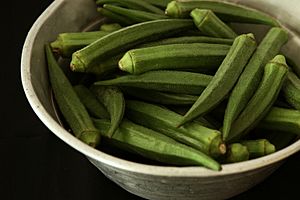

Finding enough workers was a big problem in Louisiana. In 1717, John Law, a French official, decided to bring African slaves to Louisiana. He wanted to develop the plantation economy. The Royal Indies Company controlled the slave trade.
Between 1723 and 1769, most enslaved people came from modern-day Senegal, Mali, and Congo. Many were from the Wolof and Bambara groups. Later, more enslaved people came from Benin.
Africans played a big part in creating Louisiana's Creole society. They brought okra from Africa, which is used in gumbo. The Code Noir said that enslaved people should receive Christian education. But many also practiced animism and mixed it with Christianity. The Code Noir also gave freed slaves full citizenship.
Louisiana's slave society developed its own Afro-Creole culture. This included religious beliefs and the Louisiana Creole language. Enslaved people brought their cultural practices, languages, and religious beliefs. These were key parts of Louisiana Voodoo. After the Haitian Revolution, many people from Saint-Domingue (now Haiti) also came to Louisiana. They added to the Voodoo traditions.
Cajuns in Louisiana: A New Home
- Further information: Cajuns and Cajun-Creole
In 1765, thousands of Acadians came to Louisiana. They were French colonists from Acadia (now in Canada) who had been forced out by the British. They settled mostly in southwestern Louisiana, in a region now called Acadiana. The governor welcomed them, and they became the ancestors of Louisiana's Cajuns.
Americanization of the Cajun Country
Between the 1950s and 1970s, the United States tried to make the Cajun Country more American. They created segregation and made people identify as "white" Cajuns or "black" Creoles. Younger generations were encouraged to stop speaking French and abandon French customs. White or Indian Cajuns became more like Anglo-Americans. Black Cajuns became more like African Americans.
Cajuns looked to the Civil Rights Movement for inspiration. They wanted to bring back Louisiana's French culture. A Cajun student protester in 1968 said, "We're slaves to a system. Throw away the shackles... and be free with your brother."
St. Dominicans in Louisiana: A Population Boom
- Further information: Saint-Domingue and Dominican Creoles
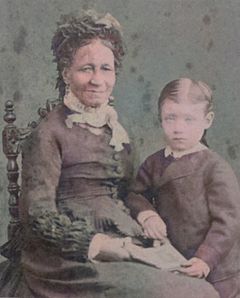
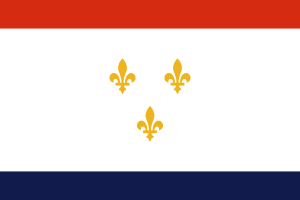
In the early 1800s, many refugees from Saint-Domingue (now Haiti) came to New Orleans. This nearly tripled the city's population. More than half of all refugees from Saint-Domingue settled in Louisiana. These refugees included both white people and Creoles of color. They sometimes brought slaves with them.
Officials wanted to limit the number of free Black men. But Louisiana Creoles wanted more French-speaking people. Many refugees who had first gone to Cuba also arrived in New Orleans.
Almost 90% of immigrants to the territory settled in New Orleans. The arrival of St. Dominicans from Cuba in 1809 doubled the city's population. New Orleans became 63% Black, a higher percentage than Charleston, South Carolina.
The Dominican Creoles brought special skills and culture. This helped Louisiana grow quickly and become a state. One Louisiana Creole said that the French Revolution and events in Saint-Domingue brought many talented people to the area. This helped the population and wealth grow.
Louisiana Creole Exceptionalism: Wealth and Education
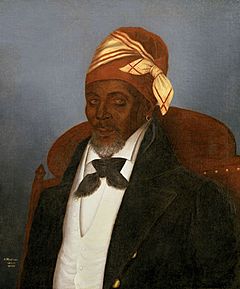
Louisiana grew very fast after becoming a state.
By 1850, one-third of all Creoles of color owned property worth over $100,000. They were wealthy business owners, doctors, and real estate developers. They owned large estates in French Louisiana. Some aristocratic Creoles of Color were very rich, like Aristide Mary, who owned over $1,500,000 in property.
Most boys from wealthy Creole families were sent to France for an excellent education.
Louisiana had a three-tiered society, like other Latin American countries. It had the wealthy (grands habitants), the middle class (bourgeoisie), and the common people (petits habitants). This mix of cultures and races created a unique society in America.
Minnesota French: The "Star of the North"
The history of French in Minnesota is tied to Canadian settlers. Explorers like Louis Hennepin and trappers like Pierre Parrant helped bring French to the area early on.
French explorers like Pierre-Esprit Radisson and Médard des Groseilliers likely reached Minnesota in 1654. They explored and traded furs with Native Americans.
A few years later, explorer Cavelier de la Salle explored the Mississippi. He called this region "L'étoile du Nord" (Star of the North). This became Minnesota's state motto.
Many early European settlers in Minnesota were from Canada. Pierre Parrant, born in Michigan in 1777, was a trapper and fur trader. The Red River Métis community also helped keep French alive in Minnesota.
Since 1858, Minnesota's state seal has featured the French motto "L'étoile du Nord."
Today, French is still spoken in Minnesota. There are bilingual schools and French classes in universities. Local groups like AFRAN support events celebrating French heritage, like the Chautauqua Festival in Huot.
Minnesota shares a border with French-speaking Canada, so French exchanges are common. In 2004, about 35% of Minnesota's goods were exported to French-speaking countries.
Mississippi Creoles: Early Settlements
In April 1699, French colonists built the first European settlement at Fort Maurepas (Old Biloxi). It was near present-day Ocean Springs. Pierre Le Moyne d'Iberville led this effort. In 1716, the French founded Natchez on the Mississippi River. It became an important town and trading post.
The French called this larger area "New France." After the French and Indian War, the British took control of the French territory.
Biloxi: First Capital of French Louisiana
- Further information: Biloxi, Mississippi
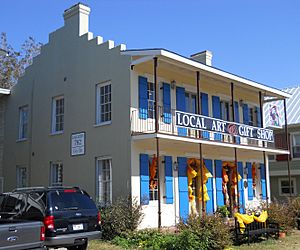
Old Biloxi was finished on May 1, 1699. French explorer Pierre Le Moyne d'Iberville appointed his brother Jean-Baptiste Le Moyne de Bienville as second in command.
D'Iberville wanted to build a colony along the Mississippi River. But he couldn't find a good spot because of flooding. So, he chose a high place on the northeast shore of Biloxi Bay. They started building the fort on April 8 and finished it by the end of the month. They also carved the Iberville stone, claiming the land for France.
About 100 people stayed at Fort Maurepas when Iberville sailed back to France. These included soldiers, Canadians, workmen, and sailors.
Few colonists knew how to farm, so the colony struggled to feed itself. The climate and soil were different from what they knew. When d'Iberville returned in 1700, he brought more Canadian immigrants and supplies. He wanted them to raise buffalo, look for pearls, and find mines.
In 1700, Le Sueur was sent to the upper Mississippi to build a fort in Sioux country. Canadians also came down the Mississippi from Quebec.
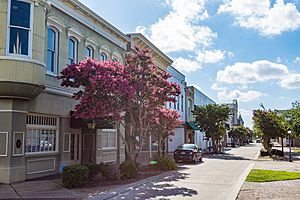
The colonists suffered from tropical diseases. Many died from yellow fever, including the governor. Bienville became the new commander.
In September 1700, Choctaw warriors asked the French for help fighting the Chickasaw. In December 1700, news came that d'Iberville had arrived with ships. The garrison was low on food and had lost many men. Bienville was ordered to move the colony to the Mobile River.
On January 5, 1701, Bienville left Biloxi, leaving 20 men at the fort. He began building Fort Louis de la Mobile near present-day Mobile. This became the main center of the Gulf Coast colony for nine years.
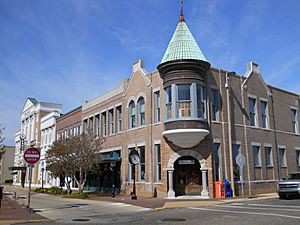
In 1717, a new fort, New Biloxi (Nouveau-Biloxi), was built west of Old Biloxi. In 1719, Fort Maurepas (at Old Biloxi) burned down and was never rebuilt.
In 1719, the capital of French Louisiana moved from Mobile to Old Biloxi. But because of hurricanes and shifting sand, the capital moved again in 1722. Governor Bienville moved it to a new inland harbor town called La Nouvelle-Orléans (New Orleans).
Natchez, Mississippi: A Strategic Location
French colonists established Natchez in 1716. It was one of the oldest and most important French settlements in the lower Mississippi River Valley. After France lost the French and Indian War, Natchez went to Great Britain in 1763. British officers who served in the war received land grants there. They started plantations and brought their upper-class lifestyle.
From 1779, Spain ruled the area. After the American Revolutionary War, Great Britain gave the territory to the United States. But Spain, who had taken Natchez from the British, didn't want to give it up.
In 1797, Major Andrew Ellicott of the United States raised the first American Flag in Natchez. He claimed Natchez and all former Spanish lands east of the Mississippi for the United States.
Natchez became the capital of the Mississippi Territory and then of the state of Mississippi. Its location on a bluff overlooking the Mississippi River made it a key center for trade and cultural exchange. It held this position for two centuries.
Ohio French: "La Belle Rivière"
La Belle Rivière: The Beautiful River
- Further information: Ohio Country
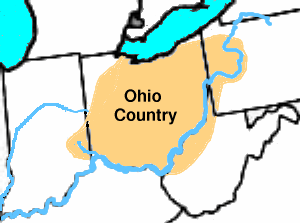
In the 1600s, the French were the first Europeans to explore what became known as Ohio Country. In 1663, it became part of New France. Robert La Salle explored northeastern Ohio in 1669.
During the 1700s, the French set up trading posts to control the fur trade. These posts were connected to their settlements in Canada and the Illinois Country. Fort Miami was built in 1680.
By the 1730s, Native American groups like the Delaware and Shawnee moved to the Ohio Country. The Wyandot and Ottawa came from the north. The Miami lived in western Ohio.
By the mid-1700s, British traders were competing with the French. The British occupied a trading post called Loramie's Fort. The French attacked it in 1752. In the early 1750s, George Washington was sent to survey the Ohio Country. The fight for control of this land led to the French and Indian War.
The Treaty of Paris in 1763 gave the Ohio Country to Great Britain. The region often saw conflicts between different tribes during this time.
Wisconsin French: Fur Traders and Settlers
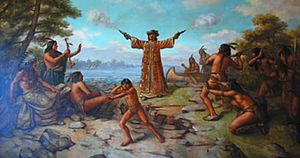
The first European to visit Wisconsin was likely French explorer Jean Nicolet in 1634. He came ashore near Green Bay. Pierre Radisson and Médard des Groseilliers visited Green Bay again in the 1650s to trade furs with Native Americans. In 1673, Jacques Marquette and Louis Jolliet traveled the Fox-Wisconsin Waterway to the Mississippi River.
Frenchmen like Nicholas Perrot continued the fur trade in Wisconsin through the 1600s and 1700s. But the French didn't make permanent settlements until after Great Britain won control in 1763. Even so, French traders stayed in the region. Some, like Charles de Langlade, settled permanently in Wisconsin.
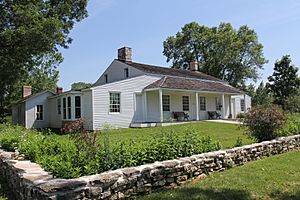
The British took over Wisconsin during the French and Indian War. They gained control of Green Bay in 1761 and all of Wisconsin by 1763. Like the French, the British were mostly interested in the fur trade.
The first permanent settlers in Wisconsin were mostly French Canadians, some Anglo-Americans, and a few African American freedmen. Charles de Langlade is seen as the first settler. He started a trading post in Green Bay in 1745 and moved there permanently in 1764. Settlement also began at Prairie du Chien around 1781.
The French residents called Green Bay "La Baye." But British fur traders called it "Green Bay" because the water and shore looked green in spring. The British name eventually stuck. British rule didn't hurt the French residents much. The British needed the French fur traders, and the French traders needed the British's help.
The fur trade in Wisconsin grew under British rule. The first self-sustaining farms were also started. From 1763 to 1780, Green Bay was a thriving community with its own food, nice homes, and many dances and parties.


